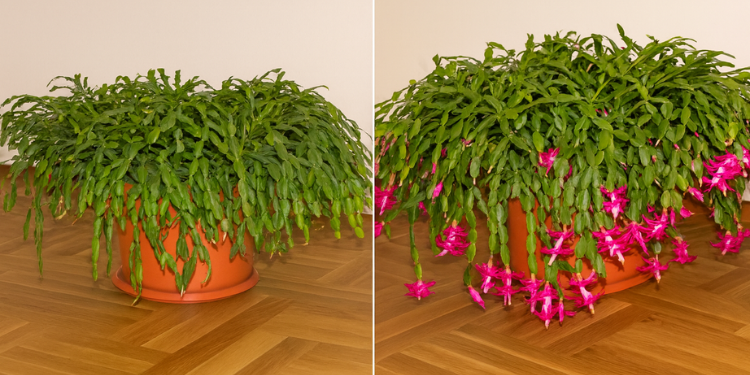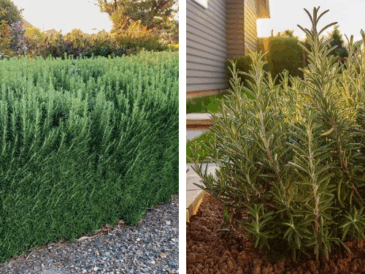A healthy Christmas cactus (Schlumbergera) is one of the most rewarding holiday houseplants you can grow.
With its arching stems and brilliant winter blooms, it can light up your home during the coldest months. But what if your plant just… stops growing?
If your Christmas cactus seems stuck – no new segments, no fresh green tips, and no sign of buds – you’re not alone. Many gardeners notice slow or stagnant growth, especially after blooming season.
1. It’s Not the Right Season for Growth
Before you panic, remember that Christmas cactus has natural growth cycles.
These tropical epiphytes, native to Brazil’s shaded rainforests, don’t grow actively year-round. Instead, they go through three key phases:
- Active growth: spring through early autumn
- Dormancy (resting period): after blooming, usually late winter to early spring
- Budding and blooming: triggered by short days and cooler nights in fall
If your cactus is in its post-bloom rest phase, slow or no growth is perfectly normal. After it finishes flowering, the plant conserves energy and prepares for the next growth cycle.
How to Fix It:
- Don’t force new growth immediately after flowering.
- Reduce watering slightly and stop fertilizing for about 6–8 weeks.
- Keep it in bright, indirect light and cooler temperatures (around 60–65°F / 15–18°C).
- When new green segments start to appear in spring, resume normal watering and feeding.
Tip: A proper rest period ensures stronger growth later – and more abundant blooms next season.
2. It’s Not Getting Enough Light
Christmas cacti are tropical, not desert succulents. That means they love bright, indirect light – not harsh sun, but definitely not deep shade either.
Too little light is one of the most common reasons for slow growth or pale, limp segments. Without sufficient light, the plant can’t photosynthesize effectively, which directly affects energy production and new growth.
How to Fix It:
- Move your cactus near an east- or north-facing window where it gets gentle morning or filtered light.
- If your home is dim in winter, supplement with a grow light for 8–10 hours per day.
- Rotate the pot every few weeks to ensure even light exposure on all sides.
Warning: Avoid strong direct afternoon sun, which can scorch the pads or turn them reddish-purple – another sign of light stress.
Pro tip: The brighter the light (without heat stress), the more compact, vibrant, and active your cactus will be.
3. You’re Overwatering (or Underwatering)
Watering mistakes are perhaps the #1 cause of slow or stunted growth.
Christmas cacti are not desert cacti – they come from humid forests where their roots cling to mossy tree bark.
They like consistent moisture, but their roots are sensitive and can quickly rot if the soil stays soggy.
Signs of overwatering:
- Mushy or yellowing stem segments
- Limp, drooping appearance
- Foul smell from the soil
Signs of underwatering:
- Shriveling or wrinkled segments
- Brittle stems that break easily
- No new growth for months
How to Fix It:
- Water only when the top 1–2 inches of soil feel dry.
- Use a well-draining mix (equal parts potting soil, perlite, and orchid bark works beautifully).
- Empty saucers after watering – never let roots sit in water.
- During active growth (spring–summer), water more often; in winter, reduce frequency.
A balanced watering rhythm helps the roots breathe, absorb nutrients, and stimulate steady new growth.
4. It Needs Fresh Soil or a Bigger Pot
If your Christmas cactus hasn’t been repotted in over 2–3 years, it may simply have outgrown its container.
Over time, soil compacts, nutrients deplete, and roots become tangled – all of which can stunt growth.
A rootbound or nutrient-starved cactus can’t push out new segments because it’s struggling just to survive.
How to Check: Gently lift the plant from its pot. If roots are circling tightly around the soil or growing through the drainage holes, it’s time for an upgrade.
How to Fix It:
- Repot every 2–3 years in spring, right before active growth starts.
- Choose a pot that’s only 1–2 inches wider than the old one.
- Use a fresh, light, airy mix (cactus or orchid soil blended with perlite).
- Add a bit of compost or worm castings for slow-release nutrients.
After repotting, water lightly and keep in indirect light for a week to allow roots to settle.
Tip: Never repot right before or during flowering – it can shock the plant and delay growth.
5. It’s Missing Essential Nutrients
A Christmas cactus that grows slowly despite good light and watering might simply be hungry.
Like all flowering plants, it needs a balance of nitrogen (N), phosphorus (P), and potassium (K) to build healthy new tissue and sustain blooms.
If you haven’t fed your plant in months (or years), the soil may be depleted.
Signs of nutrient deficiency:
- Pale, yellow-green segments
- Weak or thin stems
- No new growth even in spring
- Reduced or no flowering
How to Fix It:
- Feed monthly from March through September with a balanced liquid fertilizer (10-10-10 or 20-20-20) diluted to half strength.
- Stop feeding about 6 weeks before expected blooming time in fall.
- Alternatively, use an organic option like compost tea or worm castings for a gentle, natural boost.
Bonus tip: A small pinch of Epsom salt (magnesium sulfate) once every two months helps promote strong, green growth and better flower formation.
6. Temperatures Are Too Extreme
Christmas cacti are tropical – they don’t like temperature extremes.
Growth slows dramatically if your plant is exposed to drafts, heat vents, or cold windowsills.
Sudden temperature shifts stress the plant, causing it to conserve energy instead of growing new segments.
Ideal temperature range:
- Day: 70–80°F (21–27°C)
- Night: 60–65°F (15–18°C)
How to Fix It:
- Keep your cactus away from radiators, fireplaces, and air conditioners.
- Avoid placing it directly on cold windowsills in winter.
- During the rest period after blooming, maintain a steady 55–60°F (13–15°C) to encourage future flowering.
Pro tip: Consistent, mild temperatures mimic its natural habitat – helping it grow strong, glossy segments and setting it up for heavy blooming later in the year.
7. It’s Lacking Humidity and Airflow
While many people treat Christmas cacti like desert plants, they actually come from the humid, misty rainforests of South America, where they grow as epiphytes in tree branches.
In dry homes – especially in winter when heating is on – the air becomes too dry, leading to slowed growth, brittle tips, and brown edges.
How to Fix It:
- Maintain humidity around 50–60%.
- Place your plant on a pebble tray filled with water (but don’t let roots touch the water).
- Mist lightly every few days with distilled or filtered water.
- Keep air circulating gently to prevent fungal problems.
Balanced humidity helps your cactus absorb moisture through its leaves and promotes healthy cell growth – crucial for new stem development.
Bonus: It May Need Pruning to Stimulate Growth
If your cactus hasn’t put out new segments in a while, it might be time for a trim. Pruning not only encourages new growth but also keeps the plant bushy and symmetrical.
How to Prune:
- Use clean scissors or twist off the last segment or two from each stem tip.
- You can root these cuttings in fresh soil to create new plants.
- Perform pruning in late spring or early summer, during the active growth phase.
This gentle stress stimulates branching and faster regrowth – much like a haircut for your plant.
How to Encourage Faster Growth Year-Round
Once you’ve addressed the issues above, a few small adjustments can keep your Christmas cactus thriving and growing beautifully all year long.
1. Provide Steady Indirect Light
Position it where it gets bright but filtered sunlight, such as near an east-facing window. Rotate occasionally to keep growth even.
2. Maintain Even Moisture
Never let the plant dry out completely, but avoid soggy soil. The “soak and dry” approach works best – water thoroughly, then let the top inch dry before watering again.
3. Feed During Growth Season
A light monthly feeding in spring and summer provides energy for segment growth and bud formation later on.
4. Mimic Natural Conditions
Remember, your Christmas cactus isn’t from the desert. It evolved in humid, forested areas – meaning it loves gentle light, moisture, and airflow, not extremes.
5. Give It Rest After Blooming
Once it’s done flowering, reduce watering and stop feeding for about 6 weeks. This rest helps it store energy for new growth.
When to Expect Noticeable Growth
With proper care, you’ll usually see new segments emerging in spring – bright green and tender at first. Under the right conditions, these segments lengthen quickly, creating lush cascades of growth by summer.
If you don’t see new tips forming by late spring, recheck light, soil, and watering habits. Even a small correction can make a big difference within a few weeks.
Frequently Asked Questions
Q: How long does it take a Christmas cactus to grow?
A: A healthy plant can add several new segments per stem each year. It typically takes 2–3 years for a young cutting to mature into a full, blooming plant.
Q: Does fertilizer really help it grow faster?
A: Yes – during active growth, feeding every 4–6 weeks provides nutrients for strong stems and abundant blooms. Just remember to stop feeding before the blooming period begins.
Q: Can too much sunlight slow growth?
A: Absolutely. Direct midday sun can scorch or stress your cactus, slowing development. Always opt for bright but indirect light.
Q: Is pruning necessary?
A: Not required, but recommended. Pruning stimulates branching and keeps your cactus compact and vigorous.
If your Christmas cactus is growing slowly, it’s usually your plant’s way of saying, “I need a small adjustment.”
Whether it’s low light, compact soil, inconsistent watering, or lack of nutrients, each issue can be easily corrected.




